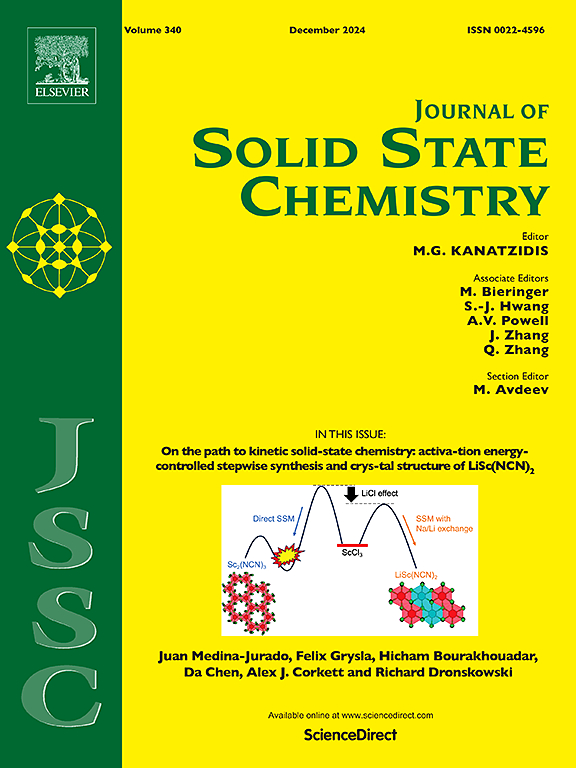Synthesis, crystal structure, luminescent and magnetic properties of bimetallic complex and hydrogen-bonded ionic framework of 1,2,4,5-benzenetetracarboxylate
IF 3.2
3区 化学
Q2 CHEMISTRY, INORGANIC & NUCLEAR
引用次数: 0
Abstract
A new bimetallic complex and a new hydrogen-bonded ionic framework (HIF) containing 1,2,4,5-benzenetetracarboxylate of the formulae [Co(C10H2O8)(H2O)4][Ni(H2O)6] (1) and [C10H4O8]2[Ni(H2O)6][Zn(H2O)6] (2) were synthesized. The compounds were characterized by elemental analysis, atomic absorption spectroscopy, single-crystal X-ray diffraction, powder X-ray diffraction, infrared spectroscopy and thermal analysis. The crystal structure shows that 1 belongs to the triclinic system, space group, in which Co2+ is coordinated with O atom of carboxylate on 1,2,4,5-benzenetetracarboxylate, while Ni2+ is coordinated with six water molecules. The water molecules on [Ni(H2O)6]2+ are connected with 1,2,4,5-benzenetetracarboxylate through hydrogen bonds. 2 belongs to monoclinic system, C2/c space group, in which Ni2+ and Zn2+ are respectively coordinated with six water molecules, forming a slightly twisted octahedral structure, and are connected with each other by hydrogen bonds. Fluorescence experiments show that 1 and 2 have fluorescence properties. Variable-temperature magnetic susceptibility study (2–300 K) indicates the existence of antiferromagnetic interactions in 1 and 2.

1,2,4,5-苯四羧酸酯双金属配合物和氢键离子框架的合成、晶体结构、发光和磁性能
合成了一种新的含[Co(C10H2O8)(H2O)4][Ni(H2O)6](1)和[C10H4O8]2[Ni(H2O)6][Zn(H2O)6](2)的1,2,4,5-苯四羧酸盐的双金属配合物和新的氢键离子框架(HIF)。通过元素分析、原子吸收光谱、单晶x射线衍射、粉末x射线衍射、红外光谱和热分析对化合物进行了表征。晶体结构表明,1属于三斜系,P1的空间基团,其中Co2+与羧酸盐的O原子配位在1,2,4,5-苯四羧酸盐上,而Ni2+与6个水分子配位。[Ni(H2O)6]2+上的水分子通过氢键与1,2,4,5-苯四羧酸酯相连。2属于单斜体系,C2/c空间群,其中Ni2+和Zn2+分别与6个水分子配位,形成微扭的八面体结构,并通过氢键相互连接。荧光实验表明,1和2具有荧光性质。变温磁化率研究(2 ~ 300 K)表明1和2存在反铁磁相互作用。
本文章由计算机程序翻译,如有差异,请以英文原文为准。
求助全文
约1分钟内获得全文
求助全文
来源期刊

Journal of Solid State Chemistry
化学-无机化学与核化学
CiteScore
6.00
自引率
9.10%
发文量
848
审稿时长
25 days
期刊介绍:
Covering major developments in the field of solid state chemistry and related areas such as ceramics and amorphous materials, the Journal of Solid State Chemistry features studies of chemical, structural, thermodynamic, electronic, magnetic, and optical properties and processes in solids.
 求助内容:
求助内容: 应助结果提醒方式:
应助结果提醒方式:


